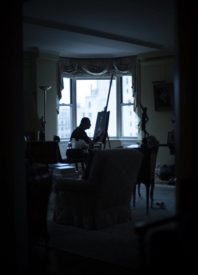
Luke Styson was a curator for Britain’s National Gallery and is also one of the subjects of Andreas Koefoed’s film The Lost Leonardo. A part of his job includes receiving emails of transparencies. Treansparencies, by the way, can be jpeg copies of paintings that the sender hopes is a lost masterpiece. As it turns out, one of those transparencies happened to be a Salvator Mundi, a painting of Jesus that, depending on who viewers ask, is the work of either a student of a student of Leonardo or by the master himself.
Styson was one of the art experts who agreed that the Salvator was a Leonardo. What viewers eventually see, nonetheless, is an interview heavy film – not that that’s a bad thing. Here, we hear from subjects from either the yay or the nay camp. Leonardo talks to museum directors who couldn’t accept the piece because of debate behind it. It then traces other things, like how the market inflated the painting’s price. It also shows what it means for a museum or a person to be able to afford such a painting.
What makes The Lost Leonardo interesting is how it depicts cities. Cities like New York and European port cities where dealers and buyers store their art. They do this to artworks instead of enjoying them or loaning them to the public. It has its share of drone shots, showing the world that’s obviously different from the one that Leonardo lived in. But it’s mostly an indoor film, showing interiors that are either antiseptic or opulent or messy. In a way, this film, just like its titular painting, transforms those interviews into portraits. Its subjects submit to the camera to our perpetual judgment.
Viewers can decide which ones look like they were scam victims or rich douchebags. That judgement specifically falls on the film’s ambiguous antihero, art restorer Dianne Modestini. She is one the people on the yay camp and who, depending on the scene, is either a champion or a liar or a victim. Regardless on who’s on screen though, we might have their share of nitpicks while watching this film. There are the occasional reenactment scenes. It captures a crazy aspect of the art world without leaning heavily on that insanity. Some of that nuance disappears when people in the nay camp appear on screen like Jerry Saltz who talk about the veracity of the work. It’s like they miss the point that veracity hasn’t been the focus of the discourse for decades now.
That discourse, on a personal level, took me back to my days as an art history undergrad. Either way, if Modestini is Leonardo‘s antiheroine, the film then finds an equally interesting villain in, of all people, Saudi Arabia’s Crown Prince and de facto ruler Mohammed bin Salman, who is the Salvator‘s alleged current owner. The film also chooses the Louvre’s Leonardo exhibition as an interesting denouement. And that’s because it reminds viewers of another debate surrounding the painting or art itself – whether art belongs on public museums or private ports. Good films always keeps us thinking and this one does just that.
- Release Date: 8/27/2021

